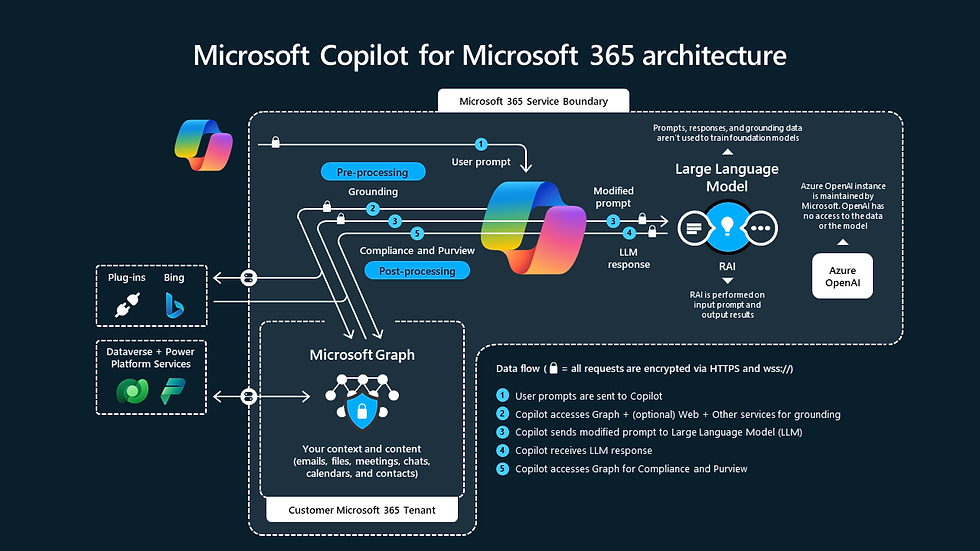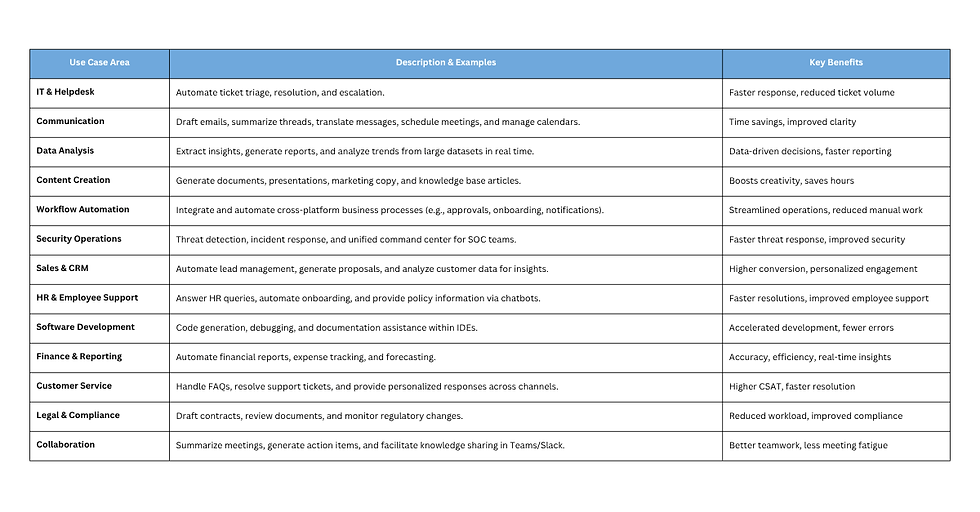Inside the Agent: What Makes a Great Copilot Tick
- Nicole Mocskonyi
- May 13, 2025
- 5 min read
Enterprise AI copilots are redefining the way businesses automate and manage knowledge-intensive tasks. Unlike basic chatbots or task-based automation tools, these advanced systems operate on large language models (LLMs) that are context-aware, secure, and deeply integrated into organizational ecosystems.
They enhance productivity by automating routine workflows while still enabling human oversight and control, ensuring transparency and reliability at every step. AI copilots are rapidly becoming indispensable for automating workflows, supporting decision-making, and enhancing productivity. But what exactly makes a great copilot tick beneath the surface?
In this blog, Cyann experts will explain what makes these systems work, from architecture to orchestration, and why they’re becoming a cornerstone of enterprise automation.
Under the Hood: Core Technical Components
Every AI copilot has a few key parts that make it tick. Think of it like an engine—each component is important, but it’s the coordination between them that delivers real horsepower.
1. Large Language Models (LLMs)
At the core of every copilot is a Large Language Model(LLM). GPT-4 is a popular general-purpose option, but most enterprise deployments benefit from domain-specific models or fine-tuned versions. Why? Because your IT support data doesn’t look anything like legal contracts or customer support logs. Domain specialization helps the model understand jargon, detect nuance, and generate more precise responses.
And let’s be honest—without the right context, even the best LLM is guessing. That’s where the second fundamental component comes into play.
2. Data Integration
An LLM on its own is like a genius with amnesia; it knows a lot but doesn’t remember anything specific to your organization. Through connectors like Microsoft Graph, REST APIs, or internal pipelines, copilots can be grounded in live enterprise data: ticketing systems, internal wikis, sales records, the whole nine yards.
This “grounding” reduces hallucinations and also ensures that what the AI says reflects your business reality.
3. The Orchestration Layer
The orchestration layer is what turns a passive chatbot into an agentic assistant. It parses user intent, triggers the right plugins or tools, and makes decisions about how to fulfill a request.
For instance, when a user asks, “Can you resolve this ticket and notify the requester?”—the copilot knows to
(1) Classify the issue,
(2) Generate a resolution based on historical data, and
(3) Send a response via integrated comms.

Architecture Deep Dive: The Four-Tier Model
To further understand the inner workings, let's consider a representative architecture, such as the four-tier structure employed by Microsoft 365 Copilot. This typically comprises:
User Interface (UI): The Face of Intelligence: This is the layer users directly interact with, providing a natural language interface for queries and displaying the copilot's responses. A well-designed UI ensures ease of use and accessibility.
LLM Layer: The Processing Powerhouse: This layer houses the core LLM, responsible for understanding user input, processing information, and generating relevant outputs. It's where the complex natural language processing and reasoning take place.
Data Layer: The Knowledge Reservoir: This layer encompasses the various data sources the copilot can access, facilitated by the integration mechanisms mentioned earlier.
A crucial technique employed within this architecture is Retrieval-Augmented Generation (RAG). RAG addresses the limitations of relying solely on the LLM's pre-trained knowledge by augmenting it with real-time information retrieval.
When a user poses a query, the system first retrieves relevant documents or data snippets from the data layer and then feeds this context to the LLM. This allows the copilot to generate more accurate, up-to-date, and contextually appropriate responses, significantly reducing the risk of "hallucinations" or factually incorrect information.
Security-The 4th Tier: Security is crucial at every layer, with robust protocols including encryption, role-based access control, and adherence to compliance frameworks ensuring data privacy and integrity.

Data-Driven Workflows: Turning Insight into Action
Data Input and Analysis
The copilot ingests data from diverse sources- emails, chat logs, support tickets, and business documents. Machine learning algorithms analyze these data streams to identify patterns, trends, and actionable insights, forming the basis for intelligent automation and personalized recommendations.
Natural Language Processing (NLP)
NLP capabilities enable the copilot to interpret user queries, understand intent, and generate human-like responses. This allows users to interact naturally, using everyday language, while the copilot translates these instructions into precise actions.
Decision-Making and Automation
By analyzing data and following pre-set objectives, copilots can automate routine tasks, propose solutions, and handle scheduling or workflow management autonomously. For example, they might automate IT ticket resolution, generate marketing content, or summarize legal documents.
Learning and Adaptation
Advanced copilots are known for their continuous learning. With each interaction, they gather feedback, refine their models, and improve performance. Reinforcement learning and domain-specific fine-tuning ensure that copilots remain accurate and relevant as business needs evolve.
Real-World Use Cases
Enterprises across the globe have already started leveraging co-pilot use cases to streamline operations and increase efficiency.

Challenges and Ethical Considerations: Navigating the Responsible AI Landscape
While the potential of AI copilots is immense, it's crucial to acknowledge and address the inherent challenges and ethical considerations:
Mitigating Hallucinations with RAG and Fine-tuning: Despite advancements, LLMs can sometimes generate incorrect or nonsensical information, known as hallucinations. Implementing robust RAG strategies and continuously fine-tuning the models with accurate and relevant data are crucial steps in mitigating this risk.
Balancing Automation with Human-in-the-Loop Validation: While automation is a key benefit, completely removing human oversight can be risky. Establishing effective human-in-the-loop validation processes for critical tasks ensures accuracy, accountability, and the ability to handle complex or novel situations that the AI might not be equipped to address.
Future Trends: The Horizon of Intelligent Assistance
The field of AI copilots is rapidly evolving, with several exciting trends on the horizon:
Multimodal Copilots (Text + Code + Visual Inputs): Future copilots will likely move beyond text-based interactions to incorporate multiple modalities, such as understanding and generating code, interpreting visual inputs like diagrams and images, and even processing audio. This will unlock even more sophisticated and intuitive interactions.
Self-Improving Systems via Reinforcement Learning: By leveraging reinforcement learning techniques, future copilots will be able to continuously learn and improve their performance based on user feedback and the outcomes of their actions. This will lead to increasingly intelligent and adaptive systems that become more effective over time.
How Can Cyann.ai Help?
At Cyann.ai, we understand the transformative power of AI copilots and the complexities involved in their development and implementation. Our team of experts specializes in building and deploying tailored AI copilot solutions that address your specific business needs and technical challenges. We can help you:
Define your AI copilot strategy: We work closely with you to identify key use cases and define a roadmap for integrating AI copilots into your workflows.
Develop custom LLM solutions: We can fine-tune existing LLMs or develop domain-specific models to ensure optimal performance and accuracy for your industry and organization.
Implement robust data integration pipelines: We ensure seamless and secure access to your critical data sources, enabling your copilot to provide contextually relevant information.
Build sophisticated orchestration layers: We design intelligent orchestration frameworks that coordinate various tools and actions to deliver truly agentic capabilities.
Integrate security and ethical considerations: We prioritize security and ethical AI practices, implementing measures to mitigate risks and ensure responsible deployment.
Ready to unlock the potential of AI copilots for your organization?
Contact us today for a consultation and discover how Cyann.ai can empower your technical teams and drive business efficiency.




Comments